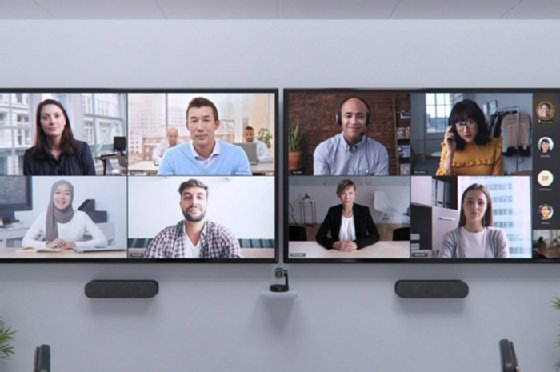
Microsoft aims Teams Rooms features at hybrid work
Microsoft will release Teams Rooms features to increase the visibility of chat messages, improve presentations and help workers sort through attendees more easily.
Microsoft is set to release a slate of Teams Rooms features next month, intending to bridge the gap between conference room and remote meeting participants.
The company this week added the changes -- including improved chat visibility, additional presentation capabilities and an update to the meeting roster -- to its product roadmap, or list of features it's working on. The features are all slated to release on Teams Rooms for Windows next month.
One of the features will let conference room participants see chat messages in "bubbles" on the screen, allowing employees to see all the conversations taking place during a meeting. Metrigy Research analyst Irwin Lazar said this will improve chat access for in-office workers, and put them on more even footing with their at-home colleagues.
"Currently, if one walks into a [conference room] and launches a meeting, they won't see the chat unless they are also logged in from their personal device," he said.
Providing greater visibility for chat during video conferences should help companies accommodate all meeting participants, however they choose to communicate. Microsoft research found that female workers are twice as likely as male employees to use chat for questions and answers during meetings.
Teams Rooms will support PowerPoint Live's Presenter mode starting next month. The feature allows speakers to choose how to display their presentations to their audiences -- with reporter mode, for instance, the slideshow is displayed over the presenter's shoulder. With this update, Teams Rooms attendees will be able to view the slideshow in the various Presenter mode layouts, as their desktop compatriots already do.

Microsoft is also making the Teams Rooms meeting roster more like the desktop version. Using an in-room console controller, office-based participants will be able to view attendees by group, bring people with raised hands to the top of the roster and ask others to join the meeting.
The large video conferencing vendors have all announced features to make meeting-room and remote-attendee experiences more equal, but they are in the early days of their efforts, Lazar said. For example, Zoom released a feature in July that places in-room participants in their own video frames to help remote attendees better read facial expressions and body language. Cisco and Microsoft have similar capabilities in the works.
Microsoft has a way to go to convince workers to drop desktop Teams meetings for Teams Rooms, said Will Wilson, IT administrator for the city of Happy Valley, Ore. The municipality has installed Teams Rooms equipment in two of its conference rooms, but most employees simply take part in Teams or Zoom calls from their desks. Wilson attributed the preference to familiarity.
"I see people [using Teams] at their desk, and they can go in and share their screen, they can mute, they can do all that stuff," he said. "They feel comfortable because they've used it."
Willem Bagchus, messaging and collaboration specialist at United Bank, said the divide between how in-person and remote employees experience work is a tough problem to crack. He said companies like Microsoft have added features at an impressive rate, but they'll never fully erase the issue.
"There's no substitute for in-person communication," he said.
Mike Gleason is a reporter covering unified communications and collaboration tools. He previously covered communities in the MetroWest region of Massachusetts for the Milford Daily News, Walpole Times, Sharon Advocate and Medfield Press. He has also worked for newspapers in central Massachusetts and southwestern Vermont and served as a local editor for Patch. He can be found on Twitter at @MGleason_TT.





